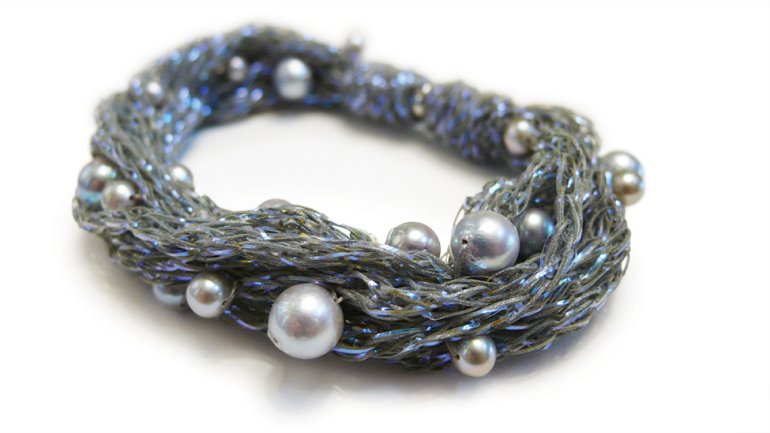A Light Touch
A Light Touch
“Materials are my obsession,” says New York-based, Pratt-trained architect and industrial designer Lara Knutson, whose reflective fabric-based work is now sold at the Museum of Modern Art Store, part of the permanent collection at Corning Museum of Glass, and slated for a July touring show called “40 under 40: Craft Futures” originating at the Smithsonian’s Renwick Gallery. “I really feel like I’m on a material adventure,” she says.
Since 2002, Knutson has been making a literally luminous series of sculptural objects, crocheted vases, conical flasks, and jewelry with titles like Nebula, Supernova, and Soft Chemistry from a fabric filigreed with 50,000 mirror-backed glass beads per square inch, which magnify light 100 times.
If “50,000 glass beads” sounds glamorous, consider that the glowy material is also used in emergency workers’ uniforms and athletic garb.
Knutson says her love of light began with seashells that glimmered on the shores of Beach Haven, New Jersey, where she grew up. When crushed, the shells “would crumble and shred, creating a kind of natural glitter,” she says. Knutson has long been drawn to phenomena that remind her of childhood on the beach: “light glistening off the water, rainstorms followed by rainbows over the ocean, reflective fish scales,” she says.
Jump ahead a couple of decades, past experiments with natural sheet mica from science surplus stores to this incandescent, microstructural textile that Knutson stumbled upon 10 years ago. It is, she says, “a synthetic version of all these natural materials” she admires.
Smooth and heavy in sheet form, slightly abrasive as yarn, but soft and lightweight when knit, this effulgent fabric is a shining example of how light can be used as effectively as – and more dramatically than – more palpable substances.
“The material responds as I move around it by flashing light at me,” the designer explains. “Even in the same room, it’s impossible for anyone to experience this material in the same way.”
Beside a Juki sewing machine in Knutson’s new studio-cum-showroom in Manhattan’s Garment District sits a custom-made Lamb knitting machine, by the last circular knitting machine manufacturer in America. (Similar machines come from China now.) “This machine is the best thing I’ve ever bought,” Knutson admits, partly because it enables her to add offbeat materials to the mix: neon threads, cashmere, nylon fishing line. She uses automation for only some pieces, though: The Nebula jewelry, for instance, is knitted on hand-cranked machines by Special Citizens, a group of adults with autism in the Bronx.
Knutson recently finished a textile for furniture and lighting showroom Mondo Collection in Manhattan’s Flatiron district, and, on a different scale entirely, is now crocheting large sheets of light-amplifying fabric into forms that generate seemingly solid rainbows. She is collaborating with a Miami architect on the design of an installation for a South Beach home, which, she says, “makes light look like an object that can be touched.”
Light is Knutson’s material; her tools are often her hands. She credits “thinking with my hands” for enabling her to study her materials and methods more deeply than if she limited herself to drawing schematics for factory fabrication.
“When you really break it down, everything is handmade, even buildings. Perhaps we all define craft based on precision, scale, and how many steps removed we are from the final outcome, but go to any factory and you’ll see people making things. Even the machines, machine parts, and raw materials are made and mined by people,” Knutson says. “There is craft everywhere.”
Shonquis Moreno is a freelance journalist working from Brooklyn and Istanbul who contributes to publications such as Wallpaper*, Whitewall, and Fast Company, as well as design books by Gestalten. She has been an editor for Surface, Dwell, and Frame magazines.

